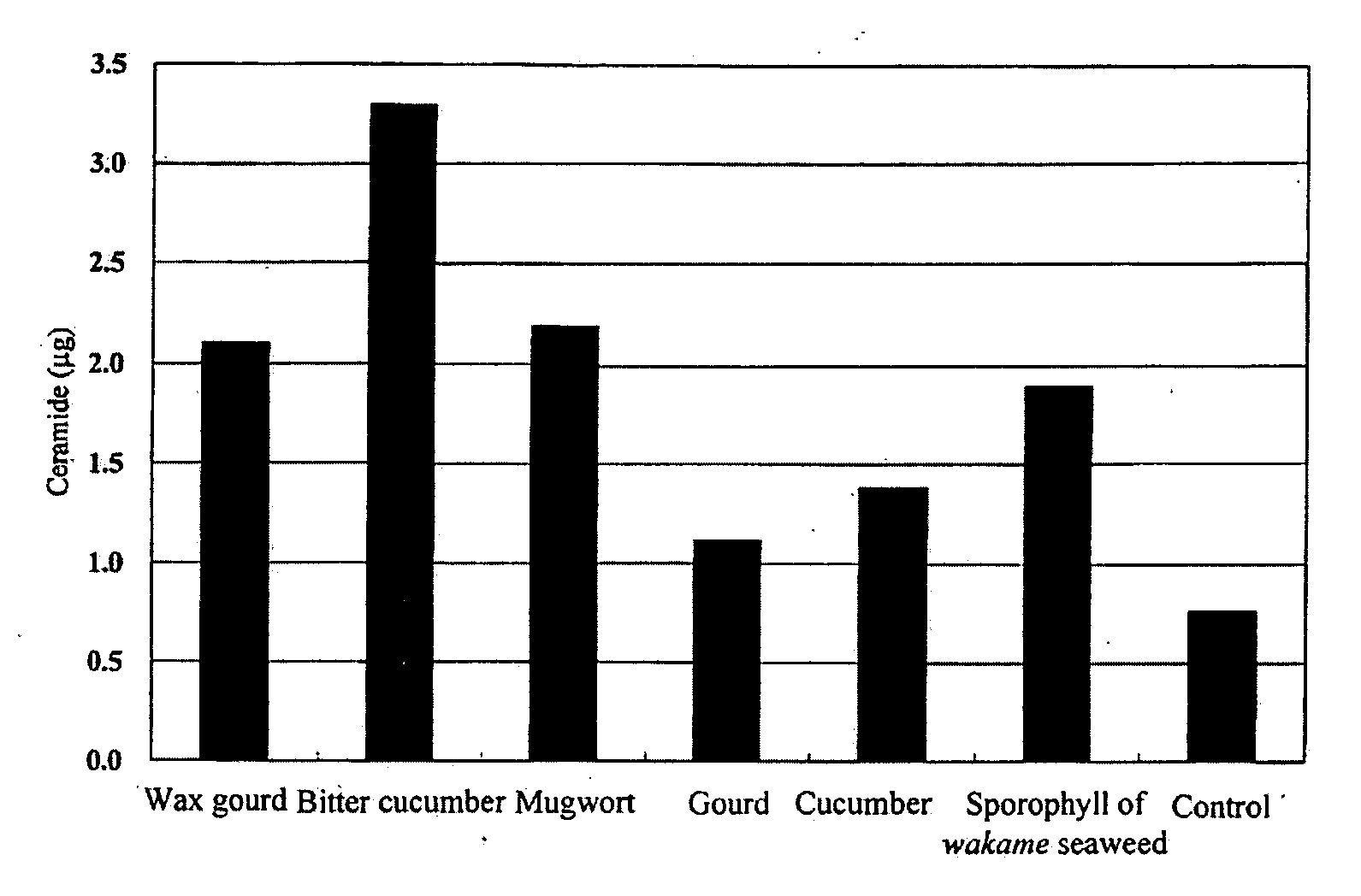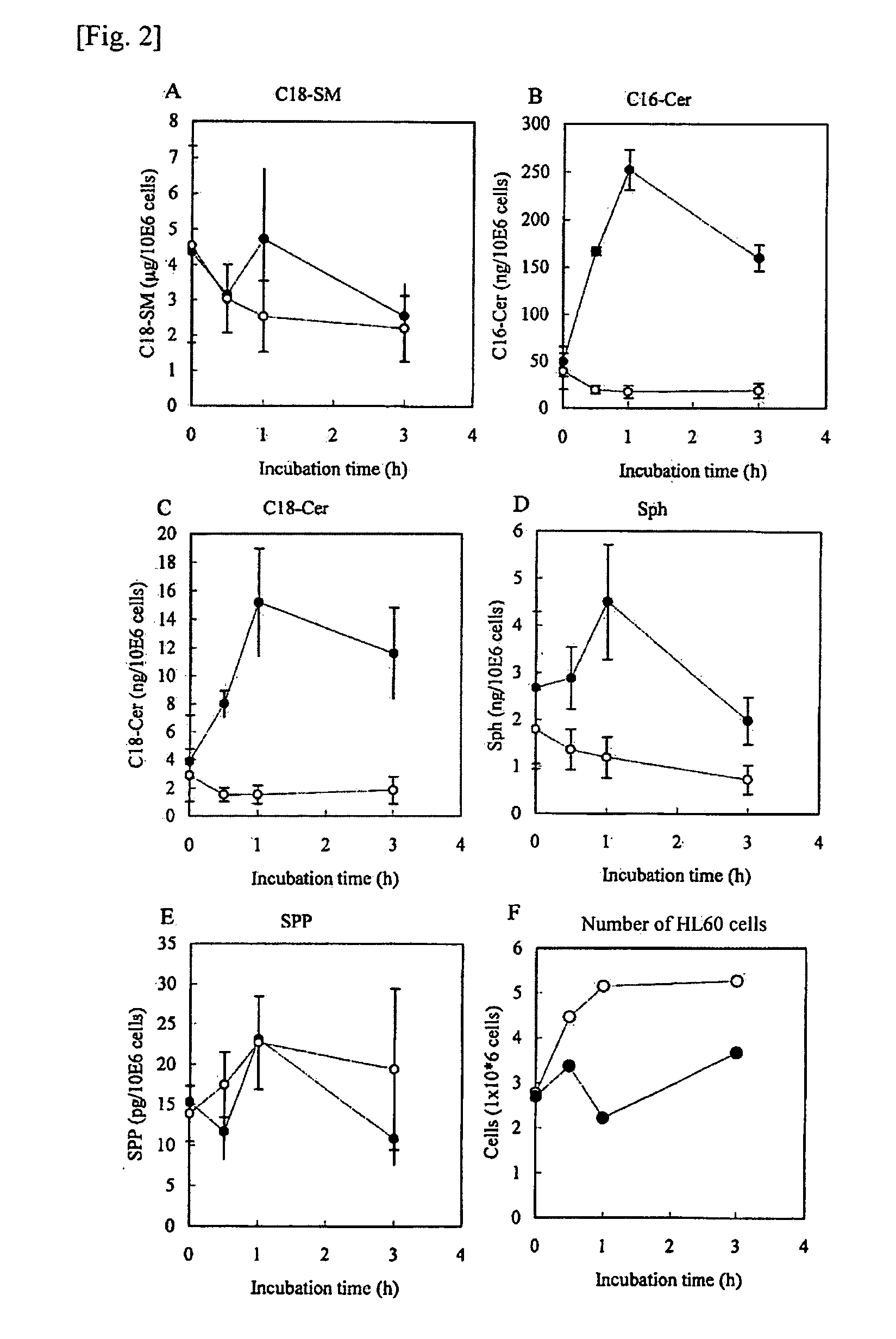Ceramidase inhibitor
a ceramidase and activity inhibitor technology, applied in the field of ceramidase activity inhibitors, can solve the problems of insufficient ceramide level in the skin, insufficient inhibitory activity of sphingoglycolipid on neutral/alkaline ceramidase, and inability to meet the needs of patients, etc., to improve the moisture retention and barrier function of the skin, improve the effect of skin ceramide content and health, and improve the effect of skin ceramid
- Summary
- Abstract
- Description
- Claims
- Application Information
AI Technical Summary
Benefits of technology
Problems solved by technology
Method used
Image
Examples
production example 1
Preparation of Ceramidase
[0095]As neutral / alkaline ceramidase, two kinds of ceramidase derived from Pseudomonas aeruginosa strain AN17 and ceramidase derived from a rat brain were used.
[0096]Pseudomonas aeruginosa strain AN17 is a bacterial strain separated from a skin released from a patient with atopic dermatitis and produces neutral / alkaline ceramidase (Journal of Biological Chemistry, 273: 14368-14373 (1998)). The bacterial strain was designated AN17 and has been deposited since Jun. 26, 1996 (original deposition date) under Accession No. FERM P-15699 with International Patent Organisms Depository, National Institute of Advanced Industrial Science and Technology, located at Central 6, 1-1-1 Higashi, Tsukuba, Ibaraki Prefecture (zip code: 305-8566), Japan. A ceramidase crude enzyme solution was prepared in the following manner.
[0097]Pseudomonas aeruginosa strain AN17 was cultured at 30° C. for 3 days in a sphingomyelin-comprising peptone yeast extract medium (0.5% peptone, 0.1% y...
example 3
Preparation of Various Plant Extracts
[0102]Ginkgo (Ginkgo biloba) leaves, white muskmelon (Cucumis melo L.) fruits, wax gourd (Benincasa cerifera Savi) fruits, cucumber (Cucumis sativus L.) fruits, bitter cucumber (Momordica charantia L.) fruits, or mugwort (Artemisia vulgaris L. var. indica Maxim.) leaves were formed into a juice by a homogenizer and then lyophilized, followed by adding 10 mL of ethanol per 1 g of the lyophilized product and leaving it overnight for extraction. The sample was filtered to give an ethanol extract. The dry weight per 1 mL of the ginkgo (Ginkgo biloba) leave extract was 15 mg, the dry weight per 1 mL of the white muskmelon (Cucumis melo L.) extract was 120 mg, the dry weight per 1 mL of the wax gourd (Benincasa cerifera Savi) extract was 53 mg, the dry weight per 1 mL of the cucumber (Cucumis sativus L.) extract was 45 mg, the dry weight per 1 mL of the bitter cucumber (Momordica charantia L.) extract was 42 mg, and the dry weight per 1 mL of the mugwo...
reference example 1
Determination of Ceramidase Inhibitory Activity
[0104]The inhibitory activity on neutral / alkaline Pseudomonas aeruginosa Ceramidase was determined in the following manner. First, 10 μL of a diluted enzyme solution prepared by diluting the Pseudomonas aeruginosa Ceramidase at a proper enzyme concentration with a diluent buffer (100 mM Tris-HCl buffer, pH 8.5, containing 5 mM calcium chloride, 0.45% bovine serum albumin) was mixed with 5 μL of inhibitor and kept at 37° C. for 10 minutes. Ten microliters of a substrate solution (Tris-HCl buffer, pH 8.5, containing 0.05 mM or 1.5 mM NBD-C12-Ceramide (manufactured by Matreya Inc.), 5 mM CaCl2, 0.5% Triton X-100) was added thereto and reacted at 37° C. for 30 minutes. The reaction was terminated by adding 75 μL of methanol, and 25 μL of aliquot of the reaction solution was analyzed by HPLC.
[0105]The inhibitory activity on the neutral / alkaline RatBrain Ceramidase was determined in the following manner. First, 10 μL of a diluted enzyme solut...
PUM
| Property | Measurement | Unit |
|---|---|---|
| pH | aaaaa | aaaaa |
| pH | aaaaa | aaaaa |
| concentration | aaaaa | aaaaa |
Abstract
Description
Claims
Application Information
 Login to View More
Login to View More - R&D
- Intellectual Property
- Life Sciences
- Materials
- Tech Scout
- Unparalleled Data Quality
- Higher Quality Content
- 60% Fewer Hallucinations
Browse by: Latest US Patents, China's latest patents, Technical Efficacy Thesaurus, Application Domain, Technology Topic, Popular Technical Reports.
© 2025 PatSnap. All rights reserved.Legal|Privacy policy|Modern Slavery Act Transparency Statement|Sitemap|About US| Contact US: help@patsnap.com



